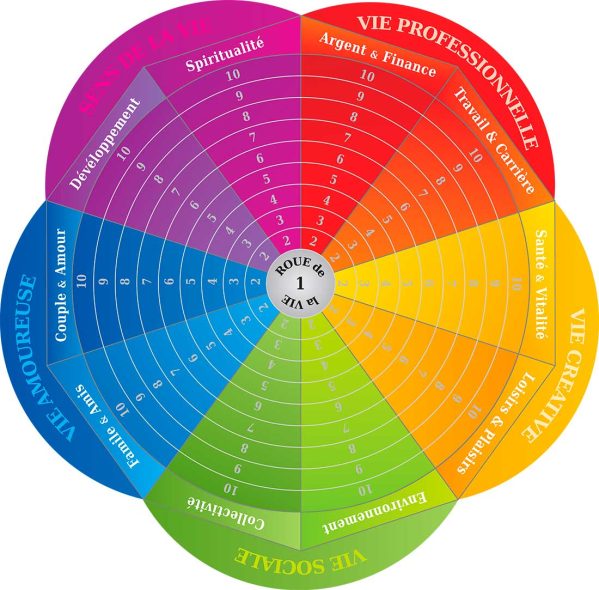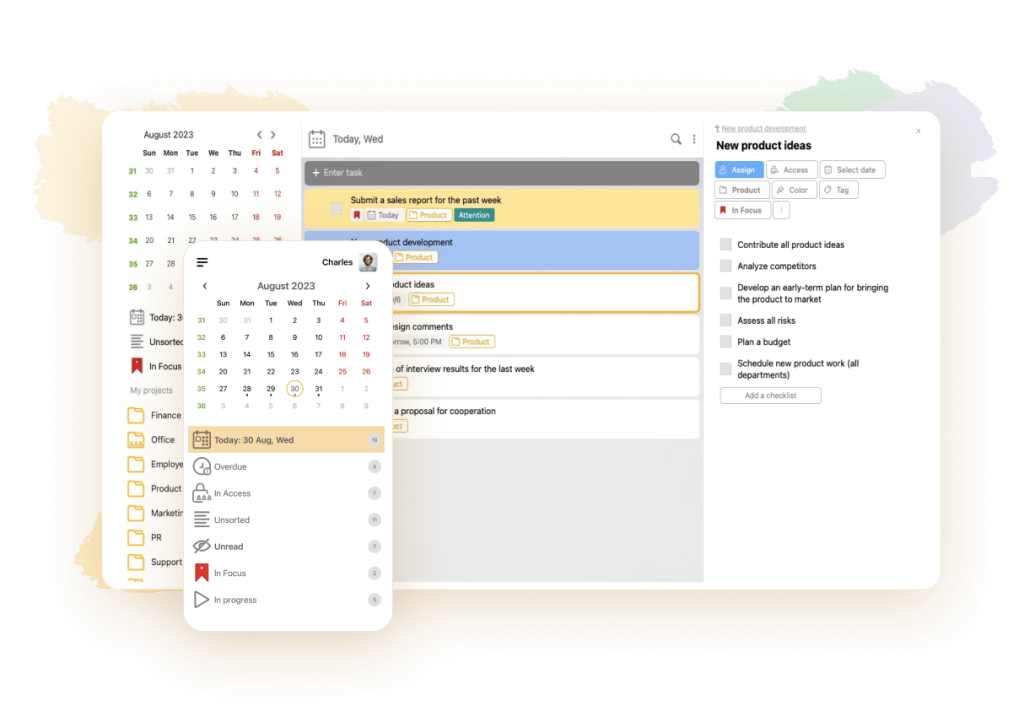Wheel of life: what it is and how to use it

The modern world sets a high pace of life. In order not to be buried under the weight of more and more tasks, you can use a time management technique called “Life Balance Wheel”. This technique helps you evaluate your life and isolate the aspects that are missing to feel happy. The Wheel of Balance gives control and allows you to make the right decisions in any area of activity. This is what our article is about.
History of the creation of the methodology

The Life Balance Wheel scheme was invented in America in the 1970s. The author was Paul J. Meyer. This man became one of the founders of coaching and gave the world developments in the field of task setting, motivation, time management and leadership. The foundation he laid became the basis for further research on behavior patterns, which is still being conducted around the world today.
Paul J. Meyer has always gravitated toward research and development of tools in the area of personal development. This has had an impact on the Balance Wheel. This chart is organized around such themes as “happiness”, “love”, “co-dependency”, “personal and business balance”.
The Wheel of Life Balance was originally divided into six sectors:
- Family and home.
- Finance and career.
- Self-development and education.
- Body and health.
- Society and culture.
- Spiritual development and ethics.
Modern Wheel diagrams may include other “sectors”. An extended list of sectors can be drawn, which are filled in depending on the area of use. This can be coaching, psychology, psychotherapy, business development, and so on.
Features of the Balance Wheel

Why has the Life Balance Wheel maintained its popularity for more than half a century? Let’s take a closer look at the peculiarities of the methodology.
The wheel provides a person with an “overhead” view of their major milestones. To analyze, one needs to look at everything that is happening from the outside. The first step in creating the Wheel of Balance is to speak your aspirations, goals and objectives. You can voice your hidden thoughts to another person or to yourself. This is a good way to structure the information in your head, as well as an exercise to make it easier to find solutions.
Every sphere of life is analyzed. Drawing a diagram of the Wheel of Balance forces a person to evaluate all aspects. When drawing the diagram, one should answer three questions:
- what this area of life means to me;
- what I want to accomplish in it;
- which area of my life is more important to me.
Human life is like an endless run. It is rare to find time and energy to think about one’s own life path in the midst of everyday worries. Take a test, ask yourself such questions as: “Where am I going in life?”, “Which goal in life is closer to me?”, “What is required of me in the current circumstances?”, “Where do I really want to go in life and what do I need to do to get there?”.
The balance wheel allows you to analyze your state as a whole. It equalizes the human tendency to fixate on one aspect of being: for example, to choose to think only about failures or only about successes.
In our reality, everything is interconnected. Solving a problem often requires a comprehensive approach, which is impossible without looking at the situation from the outside. The Wheel of Life Balance provides such an opportunity to assess what is happening.
The peculiarity of the method is its accessibility for independent mastering. It does not require special education as a psychologist or economist. The desire to change your life for the better is enough.
The balance wheel is considered a visual technique. In fact, it involves all channels of human perception of the surrounding reality. Not only vision, but also hearing, tactile sensations (kinesthetics), and rational thinking (digital channel).
Aligning channels in the Balance Wheel allows you to prioritize, distribute your efforts, and reasonably make an important decision.
Step-by-step instructions

To create your own Life Balance Wheel, use our recommendations in a simple step-by-step guide.
Determine what matters most to you. This can be areas such as health, family, children, career, money, leisure, hobbies, travel, self-development, and so on. The more areas you identify, the more detailed you will be able to examine your life.
Draw a circle and divide it into sectors, the number of which corresponds to the selected spheres.
Define your ideal in each area. For example, family for you means a beloved and loving partner, three children, your own home, traveling together, and so on. Or success in health for you means constant wellness, annual full medical check-ups, taking spa treatments every month, and so on.
In each sector, draw a 10-point scale and mark on it the level of closeness to the ideal. Then connect the marks with lines between them. This will create a graph showing your current progress in each of the areas. The polygonal figure will also clearly show in which spheres things are the best and the worst. You can then work with the result.
What should you do if the graph turns out to be a circle? This can signal either that you have been tricky when filling in the scales, or you are in a period of stagnation (in other words, stagnation). Stagnation can be followed by a decline. Therefore, the resulting circle on the chart is a signal that you need to change and build momentum in moving forward.
Think about which sectors need to be strengthened and whether it is possible to do so in an interesting way. Also highlight your strengths (these are the areas where you have maximum scores). Bringing the Wheel to balance should be done on a “Bingo” basis. That is, you need to identify a category where improvements in that category will lead to an increase in scores in other categories. For example, positive shifts in “Money” will lead to improvements in the sectors “Travel”, “Health”, “Family”, “Self-development”, etc.
Remember that the sectors are interrelated. Declining health will reduce scores in the categories of Work, Career, Travel, and Self-development. Lack of points in “Recreation” will negatively affect “Health” and “Work” in the long run. Such examples can be listed endlessly.
When drawing up the Balance Wheel, you need to take this into account. Find the central elements and turn them into a fulcrum. By building off of them, you can improve performance in “sagging” areas.
Pay attention! It is impossible to improve everything at once. You should start with a couple of areas and gradually build up your progress.
Time management to help you
Positive changes are impossible without clear planning. Modern time management is a whole science that affects all spheres of human activity. Techniques and methods of managing your own time give you the opportunity to take control of your life.
Time management implies self-organization. It also allows you to properly distribute the workload among your subordinates. In general, this science-based approach to action planning helps an individual or an organization to save resources by compressing time frames for certain amounts of work.
Improving the efficiency of actions is achieved by prioritizing goals. Urgent and important tasks are separated from those that fall into the category of “chronophages”, i.e. “time eaters”.
The principles of time management can be defined as follows:
- Planning. Determine a time frame for the task, before you begin.
- Prioritization. Before you begin, understand how urgent, important and complex the task is.
- Structuring. Capture the essence of the task, track the steps of completion, and record the receipt of results..
There are many time management schemes that work. Among them, we will mention, for example, the methods “Prepare from the evening”, “Set deadlines”, “Autofocus”, “Eating the frog” (doing the most unpleasant work first) and so on. To combat procrastination, that is, the constant pushing aside of important things for later, you can use the method of “A Few Minutes”. According to this method, you should force yourself to devote at least 5-10 minutes to an important task at the first stage, after which it will be easier to get involved in doing the whole array of work.
A good method to make yourself work is a scheme called “Small Tasks”. The beginning of the working day is devoted to preparatory work (turning on the computer, checking corporate e-mail, and so on).
In time management, it is important to distinguish between work and employment. Work refers to professional activities that contribute to career growth. Employment is the endless solution of small tasks. These tasks are not complicated, but they cause a feeling of overload, a person is spinning “like a squirrel in a wheel”.
Time management can improve the quality of work and productivity in general. In a digitally transformed world, clear time management allows a person to stay on track and focus on goals.
Set goals with LeaderTask

One advanced option to take control of your life is to use a modern task manager. It allows you to manage your employees and schedule your own tasks.
LeaderTask allows you to create tasks and assignments with fine-tuned customization. Tasks can be delegated to employees and tracked via chat. There is a calendar and an option to set reminders.
The flexible and self-contained service is built on the experience of global time and project management systems. It is suitable for:
- department heads (speeds up projects and team tasks);
- students and the self-employed (eliminates self-imposed coercion and increases productivity);
- specialists and managers (helps to focus on tasks);
- businessmen and entrepreneurs (allows you to prioritize and focus on your goals).



